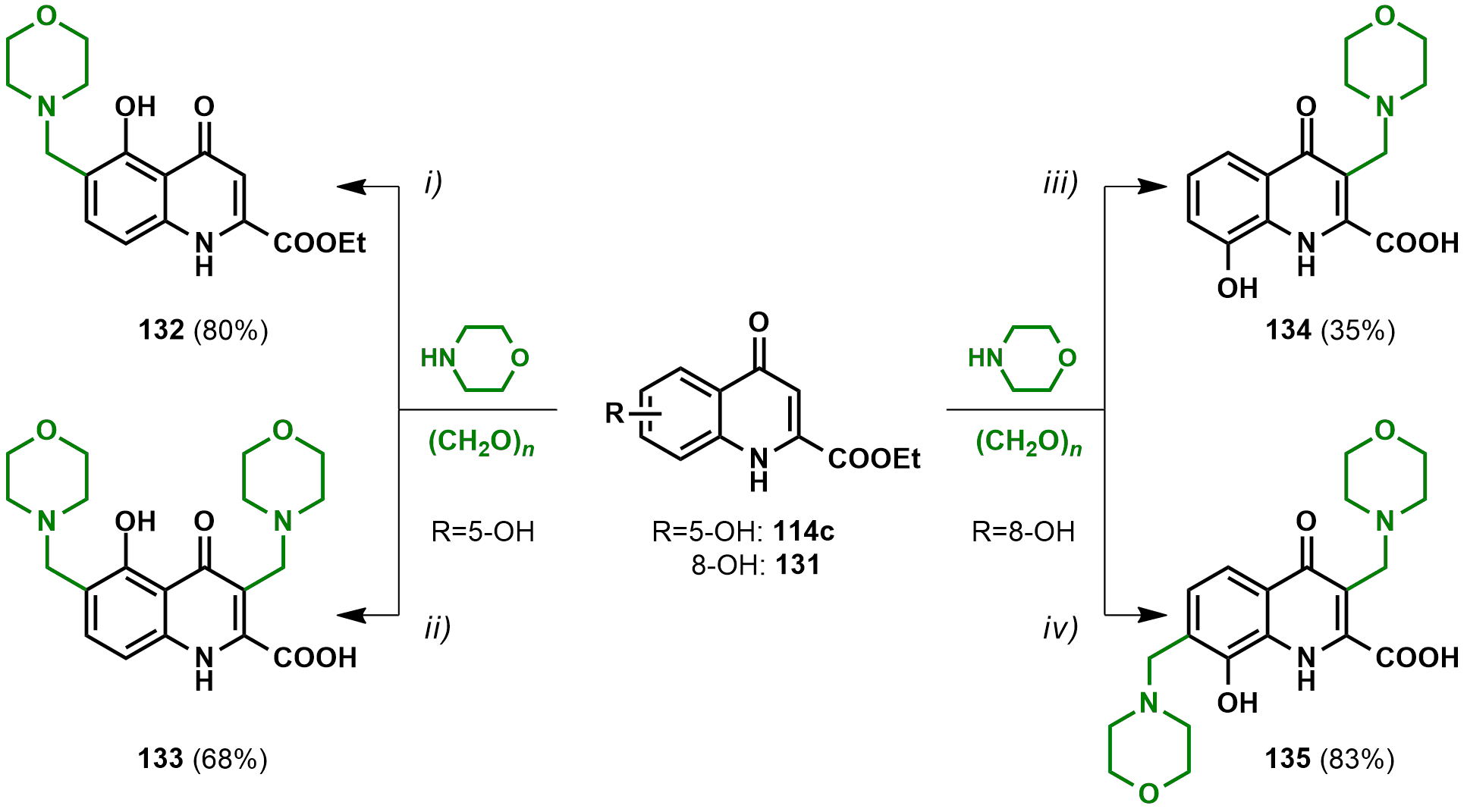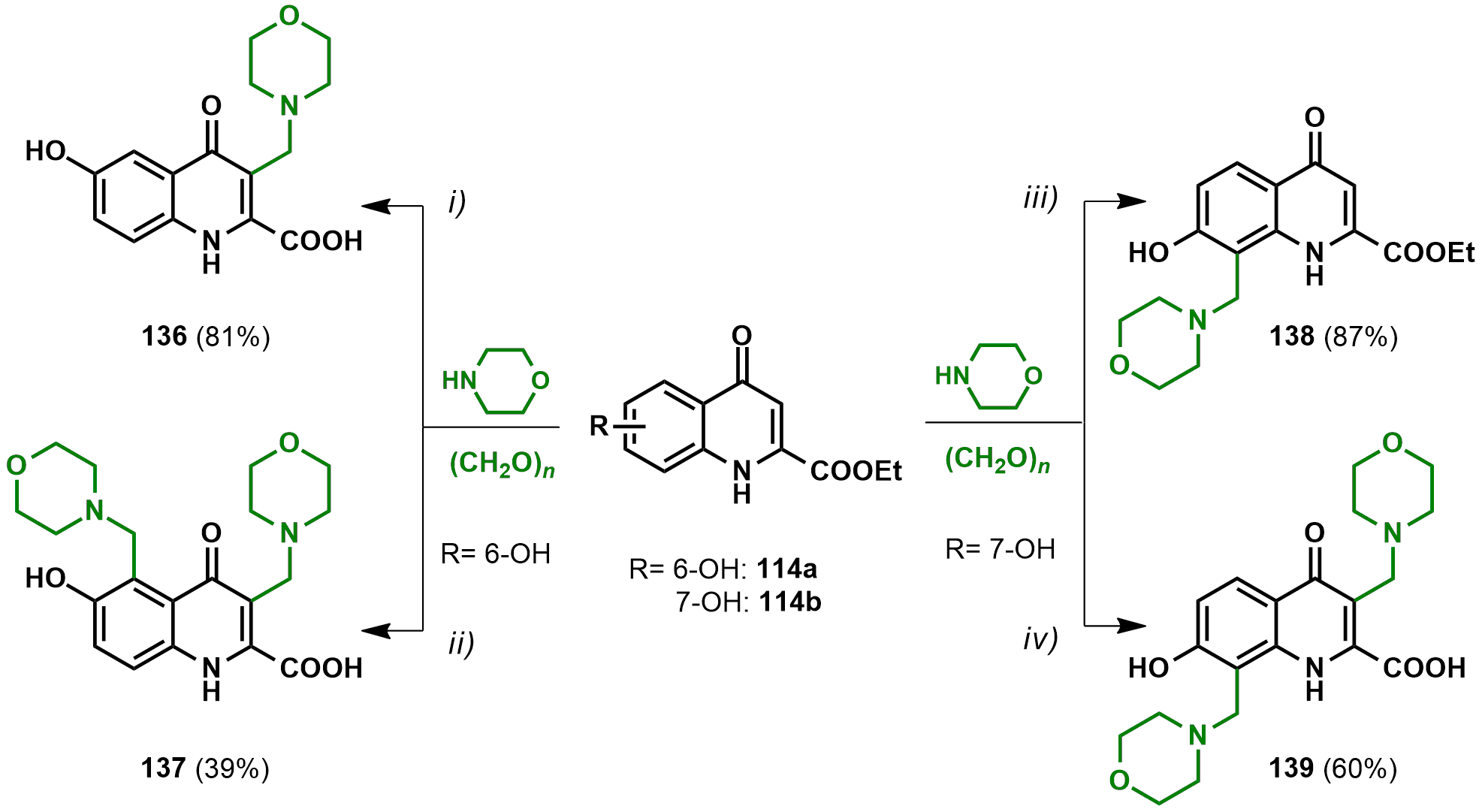Kynurenic acid (KYNA) is an endogenous neuroprotective agent of increasing importance. Several derivatives have already been synthesized, bearing an abundance of functional groups attached to the main skeleton in different positions. Several of these compounds have already been tested in biological evaluations, with several of them targeting the same receptors and biological effects as KYNA.
1. Introduction
Among the important features of KYNA, it is one of few known endogenous excitatory amino acid receptor blockers with a broad spectrum of antagonistic properties in supraphysiological concentrations. It is well established that KYNA has a high affinity towards N-methyl-D-aspartate (NMDA) receptors. Moreover, it has recently been disclosed that KYNA shows an even higher affinity towards positive modulatory binding sites at α-amino-3-hydroxy-5-methyl-4-isoxazolepropionic acid (AMPA) receptor [1][5].
Since KYNA is a neuroprotective agent able to prevent neuronal loss following excitotoxic, ischemia-induced, and infectious neuronal injuries [2][3][6,7], there has recently been increasing interest in the synthesis and pharmacological studies of KYNA derivatives. The substitution of KYNA at positions 5–8 was achieved by starting from the corresponding aniline via the modified Conrad–Limpach method [4][5][6][8,9,10]. The hydroxy group at position four was transformed to ether [6][7][8][10,11,12] or amine functions [9][10][11][13,14,15], while the carboxylic function at position two was mostly modified into the corresponding esters [6][7][8][10,11,12] or amides [12][13][14][15][16][17][16,17,18,19,20,21].
2. Mannich-Type Transformations of KYNA and Its Substituted Derivatives
2.1. C-3 Substitutions of KYNA Derivatives
Formally, KYNA can be considered to be a nitrogen-containing 1-naphthol derivative. Based upon their previous works with 1-naphthol and its
N-containing analogs
[18][19][20][21][97,98,99,100], Szatmári et al. successfully applied the ethyl ester of KYNA in the modified Mannich reaction (
mMr)
[22][101]. In this regard, to explore the scope and limitations of the reaction, different primary and secondary amines (acyclic and cyclic) were reacted with KYNA in the presence of formaldehyde (22% solution) in an optimized reaction condition of 1,4-dioxane as solvent under reflux conditions with a 5 h reaction time. The synthesis all yielded the C-3 aminoalkylated kynurenic acid derivatives
118-126 (
Scheme 1,
Table 1).
Scheme 1. Synthesis of KYNA and B-ring substituted KYNA Mannich derivatives.
Table 2. KYNA Mannich derivatives.
| Compound # |
R | 2 |
R | 3 |
R | 4 |
Yield (%) |
| 118 |
H |
2-morpholinoethyl |
H |
78 |
| 119 |
H |
2-(dimethylamino)ethyl |
Ph |
74 |
| 120 |
Me |
Me |
H |
82 |
| 121 |
Me |
Bz |
H |
85 |
| 122 |
morpholine |
H |
91 |
| 123 |
piperidine |
H |
73 |
| 124 |
N | -methyl-piperazine |
H |
78 |
| 125 |
1,2,3,4-tetrahydroisoquinoline |
H |
81 |
| 126 |
6,7-dimethoxy-1,2,3,4-tetrahydroisoquinoline |
H |
72 |
To test the effect of substituents at positions 5, 6, 7 or 8 on the
mMr, derivatives
111b–e were reacted with morpholine as a representative secondary cyclic amine in the presence of formaldehyde. Reactions were carried out under the optimized reaction conditions, concluding that aryl/alkyl substituents at position 6 or 8 and the halogen at position 5 or 7 have no significant influence on the aminoalkylation at C-3 (
Scheme 2,
127–130).
2.2. Aminoalkylations of Hydroxy-KYNA Derivatives
Regarding the 1-naphthol analogy of KYNA, the B-ring substituted derivatives show possibilities for further fascinating
mMr transformations. Compounds
114c,
131 through their analogy with 1-naphthol and
114a,b through their 2-naphthol analogy (
Figure 1), offer new possible reaction routes for the aminoalkylation.
Figure 1. Structures of hydroxy-KYNA derivatives.
2.2.1. Derivatives with Structural Similarities to 1-Napthol
Hydroxylated KYNA derivatives bearing the secondary hydroxy function at position 5 or 8 show a second 1-napthol similarity. In this case, the aminoalkylations can be expected to first undergo it in position 6 or 7, respectively, as these positions can both be regarded as the C-2 and, consequently, the most reactive position of a 1-napthol skeleton, as well as the sterically-less hindered position of the KYNA skeleton. However, this substitution route was observed by Szatmári et al. only in the case of compound
114c, the reactions first yielding
132, and subsequently
133. The morpholinomethylation in the case of the 8-hydroxy derivative (
131) first took place at C-3, yielding
134 and only after that at C-7 (
Scheme 3,
135)
[23][95].
In both cases, DFT calculations were carried out to support the observed results, showing that the reason behind the sluggish and irregular reactivity of
131 might be due to its low HOMO energy level.

2.2.2. Derivatives with Structural Similarities to 2-Napthol
In the case of the 6- and 7-hydroxykynurenic acids (
114a,b), a similarity between the skeleton and 2-naphthol can be observed, implicating that the aminoalkylations may take place in position 5 or 7, respectively. After performing the reactions, it has been observed that only compound
114b shows the expected reactivity with the morpholinomethyl function first forming at position C-8 (
138) and subsequently in position C-3 (
Scheme 41,
139). In the case of compound
114a, the reaction first led to the formation of the C-3 substituted derivative and later to the formation of the disubstituted derivative (
136 and
137). This unexpected reactivity was later investigated by DFT calculation disclosing HOMO delocalization and local NBO charges for the corresponding anion pairs theorized to form during the reaction. These calculations were in line with the experimental results implying that in the case of
114a, despite the similarity to 2-naphthol, the additional functional groups and heteroatom in the ring-system may override the reactivity expected from the sterically-less hindered 2-naphthol skeleton, resulting in the formation of
136 as a primary product
[23][95].
Scheme 3. Morpholinomethylations of the ethyl esters of 6- and 7-hydroxykynurenic acids. (i) 114a:morpholine:(CH2O)n 1:3:4.6; EtOH, MW, 80 °C, 30 min; (ii) 114a:morpholine:(CH2O)n 1:3:4.6; EtOH, MW, 80 °C, 2 h; (iii) 114b:morpholine:(CH2O)n 1:1:3; EtOH, MW, 80 °C, 1.5 h; (iv) 114b:morpholine:(CH2O)n 1:2:4; EtOH, reflux, 56 h.




